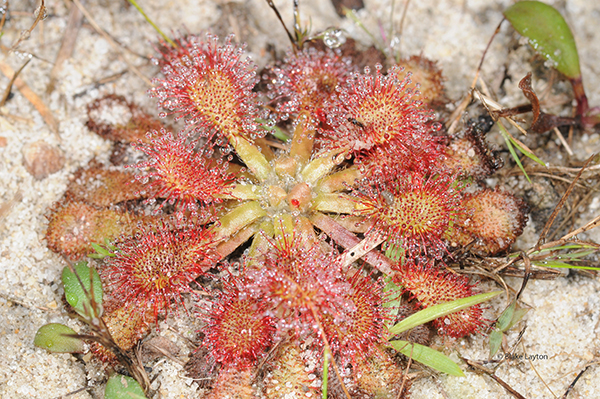Dwarf Sundew, Vol. 9, No. 06
Drosera brevifolia
Family: Droseraceae
Ask someone to name an insect-eating plant that grows in Mississippi, and most people probably will not list sundews. Venus fly traps are often the first to come to mind. Fly traps are native to the coastal plains of the Carolinas, but do not grow here. Pitcher plants may come next, and several species of pitcher plants do occur here. Butterworts, bladderworts, and sundews are less well known because they are not as large and showy. Most sundews are so small they usually go unnoticed, but if you get down on your knees and examine them closely, these are beautiful, almost jewel-like, little plants. Those little rosettes of pink, spoon-shaped leaves covered with “dew-tipped” trichomes are a Lilliputian delight.
Several species of sundews occur in the Southeast and most produce a small, ground-hugging rosette of leaves, though there is a threadleaf sundew that grows to more than a foot in height. Dwarf sundew is the smallest of the lot; the rosette diameter of this one was not much larger than a quarter, and the rosettes of large specimens rarely exceed 2 inches.
Sundews are especially impressive when in bloom. The thin bloom stalk, which arises from the center of the rosette may be 3 to 5 inches long, bearing a single white to pink, five petal bloom. There may be other flower buds on the stalk, but only one open bloom at a time. These blooms may be tiny when viewed from human perspective, but at up to ½ inch in diameter, they are huge relative to the size of the plant that produces them.
Sundews have sticky hairs, or trichomes, growing on their leaves to trap and digest insects. When a small insect such as a gnat (top, right quadrant of photo) becomes stuck on a leaf, its struggles will cause other trichomes to bend toward it, increasing contact with the sticky digestive fluids. In some species the leaves will curl toward the prey to increase contact. This allows digestive fluids to break down the insect so nutrients can be absorbed by the plant.
Dwarf sundews occur through much of the Southeast but only in very specific habitats. Like most insectivorous plants, sundews grow in moist, acidic soils where plant nutrients are less available. Although they occur in a few other places in the state, sundews are most common in boggy, sunny areas of pine savannas in south Mississippi. Crosby Arboretum is a good place to see sundews and several other insectivorous plants, but they can be found in many other areas of the coastal plains as well.
One commercial landscape in the Biloxi area has so many sundews in the lawn it is impossible to step without stepping on one or more. Frequent mowing does not seem to harm them, as they are growing as “under story plants” below the grass blades. Grass cover is thin here because the soggy, acidic soil is more suitable to sundews than turfgrass, allowing the sundews to get the sunlight they need to thrive, while catching a few small insects to use as fertilizer.
Blake Layton, Extension Entomology Specialist, Mississippi State University Extension Service.
The information given here is for educational purposes only. Always read and follow current label directions. Specific commercial products are mentioned as examples only and reference to specific products or trade names is made with the understanding that no discrimination is intended to other products that may also be suitable and appropriately labeled.
Mississippi State University is an equal opportunity institution.
Bug’s Eye View is now on Facebook. Join the Bug's Eye View Facebook group here.


